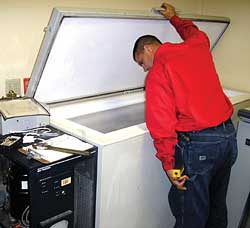
He doesn't want to risk offending customers who might be put off by a service technician with a tattoo. He knows that presentation plays an important part in his role as a representative of his employer, Rosenberg Indoor Comfort of San Antonio.
The company is operated by the family team of Lee, Betsy, and Michael Rosenberg, as well as Tom Hull and Dave Stewart. Lee Rosenberg is a former national chairman of the Air Conditioning Contractors of America (ACCA) and an active member of the San Antonio chapter of ACCA. He is also a co-founder of the Service Roundtable, an Internet support group for the HVACR trade.
The bulk of the market serviced by Rosenberg is commercial and industrial. On the day of The News' visit, Voss planned service calls at two of the company's commercial accounts.
The day began with a meeting including management, service techs, and installers. Tom Hull, vice president of service, presided over the meeting. He clicked off a series of items on the agenda. Lee Rosenberg also added some comments, noting how busy the company has been, especially in contrast to other contractors in the area, who have not been as busy as expected.
"Business is good because of you guys," he said. "We have a very good team."

The Heat Is On
The morning began with a service call on a rooftop unit. The business, located in a small industrial park, had been experiencing some difficulty getting one of its office buildings to cool down. The owners have a service agreement with Rosenberg.An error code on the LED display inside the unit indicated a possible problem with a circuit board. Voss reviewed the manufacturer's manual to get information on reprogramming the board. His initial hunch was that the rooftop unit was being asked to carry an additional load after another rooftop unit had shut down. If so, the unit would re-quire reprogramming.
Voss' hunch paid off. Within a short time after reprogramming, the error code disappeared and the unit began to lower the temperature in the office.

"I started out like everyone else, as a helper, and then learned residential service," he said.
Voss has worked in the HVACR trade for over nine years, the last five months at Rosenberg. As he prepared to leave the jobsite, a Rosenberg installation crew was preparing to install a split system on a rooftop just across the parking lot.

Laboratory Freezer Won't Freeze
The second stop of the morning involved another service agreement customer. The sprawling complex houses a biological research center.We had to pass through a security checkpoint and were issued identification badges. Rosenberg employees always carry their own identification. In addition to the bright red company shirts, employees are required to carry an identification badge with their name and photo. The badges are clipped on to their clothing.
On this particular stop, one of the facility's freezer units was not cooling down to the required -70 degrees C necessary to store experiment materials. The unit was over 20 years old and showing its age. Voss noted that the customer had replaced other units that were the same age, but for some reason they wanted to see if this one could be repaired.
"Frankly, I don't know why it won't cool down," Voss said.

On this occasion, he spoke to a different support person, who said he could safely put gauges on the compressor. After examining the system, Voss determined that one compressor was "too weak" and "not going to hang on."
He provided a report to the customer that detailed two options: repairing or replacing the freezer unit. Voss noted that the service agreement with the research facility mandated that the freezers be inspected at least twice a year, and he ventured that the customer would probably opt for replacement.
As he pulled out of the parking lot, Voss took a sip of his "Big Gulp" and headed for his next service call.
Publication date: 08/09/2004

Report Abusive Comment